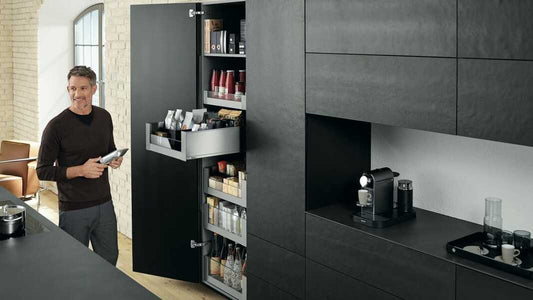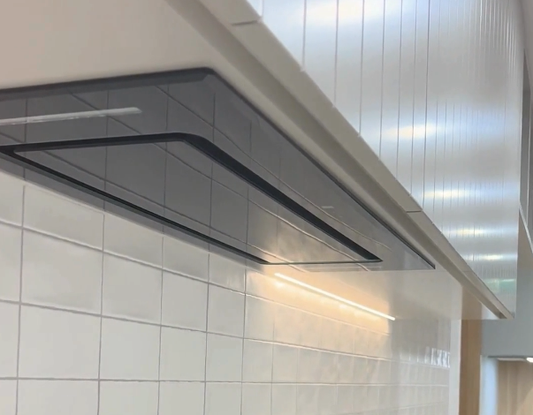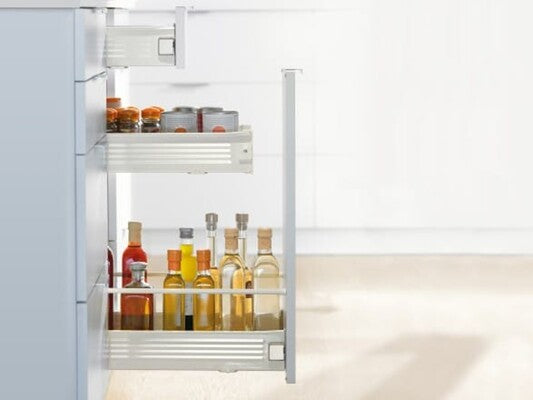
Careful consideration is required when selecting your kitchen benchtop materials. After all, there are factors of heat, water, heavy items and high traffic. Considering the function of the space and where the most wear and tear will take place in your new kitchen will allow for investment in key features that will last the lifetime of the space.
Laminate:
The process of laminating benchtops has significantly improved in recent years with the introduction of thermosetting layers of sheeting on a white HMR chipboard substrate. The substrate is used to maintain the structural integrity of the board while the finish material brings the colour, finish and durability to the product. Starting from solid colours, to timber and stone prints which are achieved with the modification of colour, depth and tone to recreate the characteristics of natural materials as well as adding a protective layer to the finished surface. This coating material can then be modified to help define grain and texture in the product while combating the effects of general wear and tear in a high traffic environment.
Benefits:
- A huge number of colours and finishes available
- Flexible layouts and shapes achievable
- Durable
Limitations:
- Maximum manufacture lengths
- Visible joins
- Effects of water on unfinished ends.
Timber:
A natural wooden slab material milled from a tree species for its colour, provides a structurally sound, solid surface suitable for benchtops while highlighting the character and texture of the chosen wood product.
Timber does require an extensive seasoning and climatisation process to reduce water content and maintain the structure of the slab which increases manufacturing cost and lead time. To reduce this turnaround time pre-finished boards are stored and other manufactured options are now available using Bamboo where resin combines the compressed grains together to form a timber look.
In order to protect the surface, a lacquer or polyurethane product must be applied. This coating will protect the wood and provide a barrier to moisture and general wear. There are also natural options available in the form of oils with properties similar to lacquer, although these will need to be applied on a more regular basis.
Benefits:
- Sustainable
- Can be refinished
Limitations:
- Requires consistent maintenance
- Affected by water and/or steam
- Discolouration over time
Engineered Stone:
Stone, manufactured using a combination of Quartz (90%), Colour pigments and Polymer resins, mixed and compressed to form a slab. The slab is then polished to form the finished product at an overall thickness of 20mm.
Once your cabinetry is installed a detailed measure is completed to ensure the stone slab is cut to the most accurate size, formed and the exposed edges polished in your chosen profile. In order to increase the thickness of a stone benchtop an MDF substrate is used between the stone and finished cabinetry height. The perimeter of the stone edges are then mitred to increase the visible thickness of the stone. This process reduces the weight of the benchtop while maintaining the structural integrity of the panel. The joins on both the surface and edges are then bonded using an epoxy adhesive in a matching colour to the stone also allowing for integration and under mount sink options.
Benefits:
- Hardwearing and durable
- As the stone is pre-finished during the manufacturing stage there is no need for sealing or coating
- Water and scratch resistant
Limitations:
- Edges can be brittle under concentrated force
- Property entry requirements restrict slab sizing
Natural Stone:
As the name suggests, it is a natural product, extracted from the earth's surface in large blocks. The process of manufacture begins when the blocks are cut into 20-30mm thick slabs and fabricated to suit the intended purpose.
Natural stone may contain markings, veining, pitting, and fissures that are a feature, this isn’t present in engineered stone and is created over thousands of years, running throughout the depth of the product to create a unique colour and character to each slab.
Photos do not do the product any justice, so it is best to select the slab in person at the stone supplier.
Sealing your natural stone is recommended, a penetrative sealant can last up to 7 years in ideal conditions when cleaned according to manufacturer instructions and will aid in maintaining the longevity of the product and reducing porosity.
Benefits:
- Durable and long lasting
- A unique feature
- Water and scratch resistant
Limitations:
- Edges can be brittle under concentrated force
- Property entry requirements restrict slab sizing
- Additional maintenance required over the lifetime of the product



